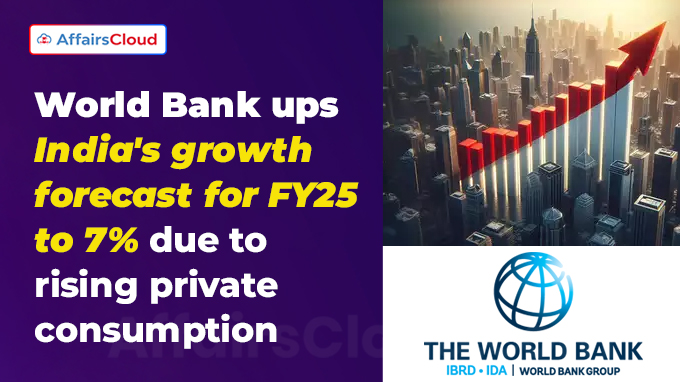 On 10th October 2024, the World Bank(WB) released a report titled “South Asia Development October 2024 Update: Women, Jobs and Growth”. It has retained India’s Gross Domestic Product (GDP) growth forecast for Financial Year 2024-25 (FY25) to 7% Year-on-Year (Y-o-Y). This growth projection is mainly attributed by higher agricultural production and robust employment growth from policy initiatives, which further boost the private consumption.
On 10th October 2024, the World Bank(WB) released a report titled “South Asia Development October 2024 Update: Women, Jobs and Growth”. It has retained India’s Gross Domestic Product (GDP) growth forecast for Financial Year 2024-25 (FY25) to 7% Year-on-Year (Y-o-Y). This growth projection is mainly attributed by higher agricultural production and robust employment growth from policy initiatives, which further boost the private consumption.
- This GDP projection of India remains unchanged from its September edition of Asian Development Outlook (ADO); it has increased by 40 basis points (bps) from its previous estimate of 6.6% (in April 2024).
- The World Bank has also retained India’s GDP growth forecast at 6.7% for FY26 (2025-26).
India-Specific:
i.As per the report, India’s GDP rate in FY25 will be the 2nd highest among the South Asian countries after Bhutan (7.2%) .
ii.The report highlighted that these estimates are in line with India’s pre-pandemic (FY17-19) average growth rate and outpaces most other major Emerging Markets and Developing Economies (EMDEs).
iii.The WB’s report has also estimated India’s fiscal deficit to reduce by 70 bps of GDP in FY25 to 7.5% of GDP due to higher revenues from improved compliance with Goods and Services Tax (GST) and a widening of the personal income tax base.
South Asia Outlook:
i.The WB has also upgraded the economic outlook for all South Asian countries, except for Bangladesh and Maldives.
ii.The WB has raised its growth projection for the South Asia region to 6.4% in 2024 from its previous estimate of 6.0%.
- It has cited certain factors like: strength of domestic demand in India and quicker recoveries in crisis-hit countries such as Sri Lanka and Pakistan, for the positive growth of South Asia.
- This upward projection positions South Asia as the fastest growing emerging economy region monitored by the World Bank.
iii.The report has further estimated that South Asia’s output will grow by 6.2% in 2025. This growth projection is mainly driven by strong private consumption in India, and increased tourism and hydropower exports in Bhutan, Nepal, and Sri Lanka.
Gender Disparity in Employment:
i.The report highlighted the persistent gender disparity in employment across the South Asia region and cited that female labor force participation in South Asia is among the lowest in the world.
ii.The report showed that the overall female labor force participation rate stood at just 32% in 2023, which is significantly lower than the 77% rate for men.
- Also, this female labor force participation rate is quite below the 54% average in EMDEs.
iii.As per the report, female labor force participation rate in most countries of the South Asian region except Bhutan, were 5% to 25% lower than in countries at similar levels.
iv.The report estimated that by raising labor force participation of women to the level of men could result in a 13% to 51% boost to GDP of the South Asia region and per capita income.
v.The report has outlined some key recommendations such as: legal reforms to enhance gender equality, measures to boost jog generations, and removal of barriers to women working outside the home like: lack of safe transport and quality child and elder care.
About the World Bank (WB):
President– Ajay Banga
Headquarters– Washington, DC, the United States of America (USA)
Established– 1944




